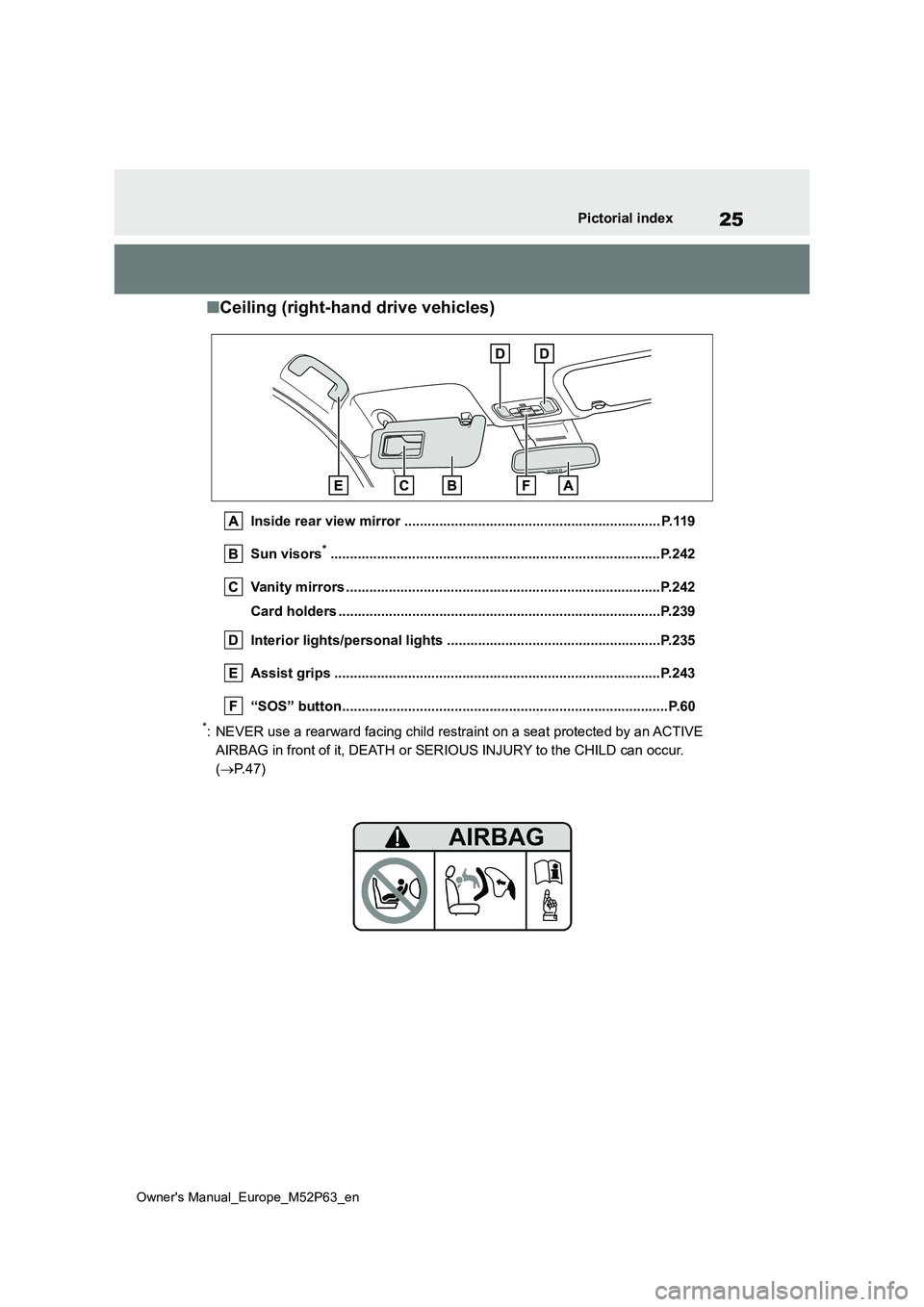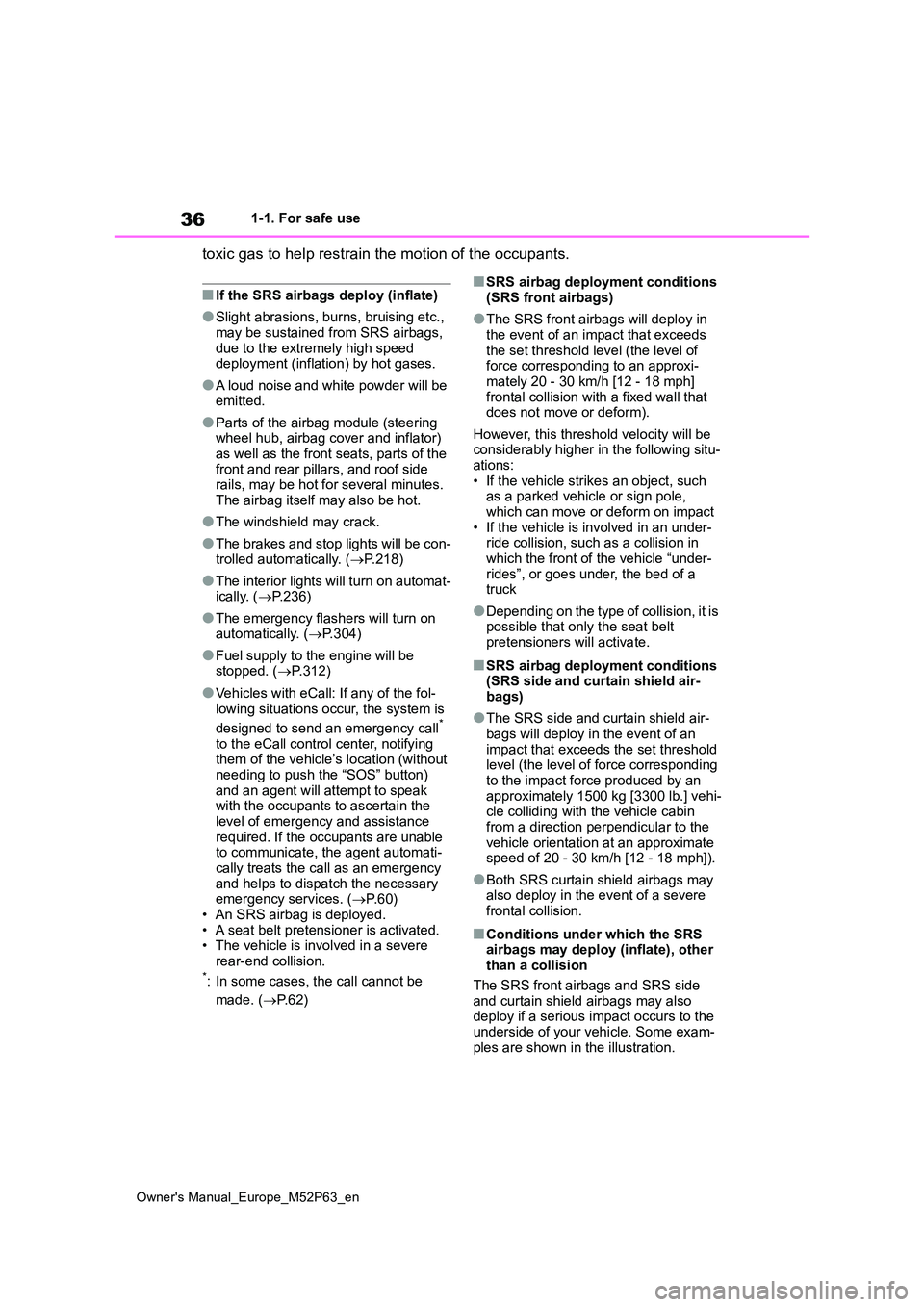2023 TOYOTA GR YARIS interior lights
[x] Cancel search: interior lightsPage 5 of 470

3
Owner's Manual_Europe_M52P63_en
TABLE OF CONTENTS
1
6
5
4
3
2
8
7
4-3. Operating the lights and wip-
ers
Headlight switch.................. 142
Automatic High Beam ......... 145
Fog light switch ................... 148
Windshield wipers and washer
.......................................... 148
4-4. Refueling
Opening the fuel tank cap ... 151
4-5. Using the driving support sys-
tems
Toyota Safety Sense ........... 153
PCS (Pre-Collision System) 158
LTA (Lane Tracing Assist) ... 170
Dynamic radar cruise control
.......................................... 179
RSA (Road Sign Assist) ...... 190
Stop & Start system ............ 194
BSM (Blind Spot Monitor) ... 199
Toyota parking assist-sensor
.......................................... 204
RCTA (Rear Crossing Traffic
Alert) ................................. 210
AWD mode select switch .... 215
GPF (Gasoline Particulate Filter)
system .............................. 216
Driving assist systems ........ 217
4-6. Driving tips
Winter driving tips ............... 224
5-1. Using the air conditioning
system and defogger
Automatic air conditioning sys-
tem.................................... 228
Heated steering wheel/seat
heaters.............................. 233
5-2. Using the interior lights
Interior lights list .................. 235
5-3. Using the storage features
List of storage features ....... 237
Luggage compartment features
.......................................... 239
5-4. Other interior features
Other interior features ......... 242
6-1. Maintenance and care
Cleaning and protecting the
vehicle exterior ................. 246
Cleaning and protecting the
vehicle interior .................. 249
6-2. Matte paint care guide (if
equipped)
Basic knowledge about matte
clear coat .......................... 252
Washing your vehicle.......... 256
Frequently Asked Questions
.......................................... 259
6-3. Maintenance
Maintenance requirements . 263
5Interior features
6Maintenance and care
Page 21 of 470

19
Owner's Manual_Europe_M52P63_en
Pictorial index
■Ceiling (left-hand drive vehicles)
Inside rear view mirror .................................................................. P.119
Sun visors*1............................................................... .....................P.242
Vanity mirrors ................................................. ................................P.242
Card holders ................................................... ................................P.239
Interior lights/personal lights ................................ .......................P.235
Assist grips ................................................... .................................P.243
“SOS” button*2............................................................... ..................P.60
*1: NEVER use a rearward facing child restraint on a seat protected by an ACTIVE
AIRBAG in front of it, DEATH or SERIOUS INJURY to the CHILD can occur.
( P.47)
*2: If equipped
Page 27 of 470

25
Owner's Manual_Europe_M52P63_en
Pictorial index
■Ceiling (right-hand drive vehicles)
Inside rear view mirror .................................................................. P.119
Sun visors*............................................................... ......................P.242
Vanity mirrors ................................................. ................................P.242
Card holders ................................................... ................................P.239
Interior lights/personal lights ................................ .......................P.235
Assist grips ................................................... .................................P.243
“SOS” button................................................... .................................P.60
*: NEVER use a rearward facing child restraint on a seat protected by an ACTIVE
AIRBAG in front of it, DEATH or SERIOUS INJURY to the CHILD can occur.
( P. 4 7 )
Page 38 of 470

36
Owner's Manual_Europe_M52P63_en
1-1. For safe use
toxic gas to help restrain the motion of the occupants.
■If the SRS airbags deploy (inflate)
●Slight abrasions, burns, bruising etc., may be sustained from SRS airbags,
due to the extremely high speed deployment (inflation) by hot gases.
●A loud noise and white powder will be emitted.
●Parts of the airbag module (steering wheel hub, airbag cover and inflator) as well as the front seats, parts of the
front and rear pillars, and roof side rails, may be hot for several minutes. The airbag itself may also be hot.
●The windshield may crack.
●The brakes and stop lights will be con-trolled automatically. ( P.218)
●The interior lights will turn on automat- ically. ( P.236)
●The emergency flashers will turn on automatically. ( P.304)
●Fuel supply to the engine will be stopped. ( P.312)
●Vehicles with eCall: If any of the fol-
lowing situations occur, the system is
designed to send an emergency call*
to the eCall control center, notifying them of the vehicle’s location (without needing to push the “SOS” button)
and an agent will attempt to speak with the occupants to ascertain the
level of emergency and assistance required. If the occupants are unable to communicate, the agent automati-
cally treats the call as an emergency and helps to dispatch the necessary emergency services. ( P.60)
• An SRS airbag is deployed. • A seat belt pretensioner is activated.• The vehicle is involved in a severe
rear-end collision.*: In some cases, the call cannot be
made. ( P. 6 2 )
■SRS airbag deployment conditions
(SRS front airbags)
●The SRS front airbags will deploy in
the event of an impact that exceeds the set threshold level (the level of force corresponding to an approxi-
mately 20 - 30 km/h [12 - 18 mph] frontal collision with a fixed wall that does not move or deform).
However, this threshold velocity will be considerably higher in the following situ-
ations: • If the vehicle strikes an object, such as a parked vehicle or sign pole,
which can move or deform on impact • If the vehicle is involved in an under-ride collision, such as a collision in
which the front of the vehicle “under- rides”, or goes under, the bed of a truck
●Depending on the type of collision, it is possible that only the seat belt
pretensioners will activate.
■SRS airbag deployment conditions (SRS side and curtain shield air-bags)
●The SRS side and curtain shield air-bags will deploy in the event of an
impact that exceeds the set threshold level (the level of force corresponding to the impact force produced by an
approximately 1500 kg [3300 lb.] vehi- cle colliding with the vehicle cabin from a direction perpendicular to the
vehicle orientation at an approximate speed of 20 - 30 km/h [12 - 18 mph]).
●Both SRS curtain shield airbags may also deploy in the event of a severe frontal collision.
■Conditions under which the SRS airbags may deploy (inflate), other than a collision
The SRS front airbags and SRS side and curtain shield airbags may also deploy if a serious impact occurs to the
underside of your vehicle. Some exam- ples are shown in the illustration.
Page 229 of 470

5
227
Owner's Manual_Europe_M52P63_en
5
Interior features
Interior features
5-1. Using the air conditioning
system and defogger
Automatic air conditioning sys-
tem ................................. 228
Heated steering wheel/seat
heaters ........................... 233
5-2. Using the interior lights
Interior lights list................ 235
5-3. Using the storage features
List of storage features ..... 237
Luggage compartment features
....................................... 239
5-4. Other interior features
Other interior features....... 242
Page 237 of 470

235
5
Owner's Manual_Europe_M52P63_en
5-2. Using the interior lights
Interior features
5-2.Using the interior lights
Rear interior light (P. 2 3 5 )
Door trim lights (if equipped)
Front interior/personal lights ( P.235, 236)
■Front
Turns the door position on/off
When a door is opened while the door
position is on, the lights turn on.
■Rear
1 Turns the light off
Interior lights list
Location of the interior lights
Operating the interior lights
Page 238 of 470

236
Owner's Manual_Europe_M52P63_en
5-2. Using the interior lights
2Turns the door position on
3 Turns the light on
Turns the lights on/off
■Illuminated entry system
The lights automatically turn on/off
according to the engine switch mode (position), the presence of the electronic key, whether the doors are
locked/unlocked, and whether the doors are opened/closed.
■To prevent the battery from being discharged
If the interior lights remain on when the engine switch is turned off, the lights will go off automatically after 20 minutes.
■The interior lights may turn on
automatically when
If any of the SRS airbags deploy (inflate) or in the event of a strong rear impact,
the interior lights will turn on automati- cally.The interior lights will turn off automati-
cally after approximately 20 minutes. The interior lights can be turned off man-ually. However, in order to help prevent
further collisions, it is recommended that they be left on until safety can be ensured.
(The interior lights may not turn on auto- matically depending on the force of the impact and conditions of the collision.)
■Customization
Some functions can be customized. ( P.359)
Operating the personal
lights
NOTICE
■To prevent battery discharge
Do not leave the lights on longer than necessary when the engine is not run-ning.
Page 337 of 470

335
7
Owner's Manual_Europe_M52P63_en
7-2. Steps to take in an emergency
When trouble arises
One of the following may be the
cause of the problem:
There may not be sufficient fuel
in the vehicle’s tank. Refuel the
vehicle.
The engine may be flooded. Try
to restart the engine again fol-
lowing correct starting proce-
dures. ( P.134)
There may be a malfunction in
the engine immobilizer system.
( P. 7 0 )
One of the following may be the
cause of the problem:
The battery may be discharged.
( P.339)
The battery terminal connec-
tions may be loose or corroded.
( P.273)
The engine starting system may be
malfunctioning due to an electrical
problem such as electronic key bat-
tery depletion or a blown fuse.
However, an interim measure is
available to start the engine.
( P.335)
One of the following may be the
cause of the problem:
The battery may be discharged.
( P.339)
One or both of the battery termi-
nals may be disconnected.
( P.273)
There may be a malfunction in
the steering lock system.
Contact any authorized Toyota retailer
or Toyota authorized repairer, or any
reliable repairer if the problem cannot
be repaired, or if repair procedures are
unknown.
When the engine does not start, the
following steps can be used as an
If the engine will not
start
If the engine will not start even
though correct starting proce-
dures are being followed
( P.134), consider each of the
following points:
The engine will not start
even though the starter
motor operates normally.
The starter motor turns over
slowly, the interior lights
and headlights are dim, or
the horn does not sound or
sounds at a low volume.
The starter motor does not
turn over
The starter motor does not
turn over, the interior lights
and headlights do not turn
on, or the horn does not
sound.
Emergency start function